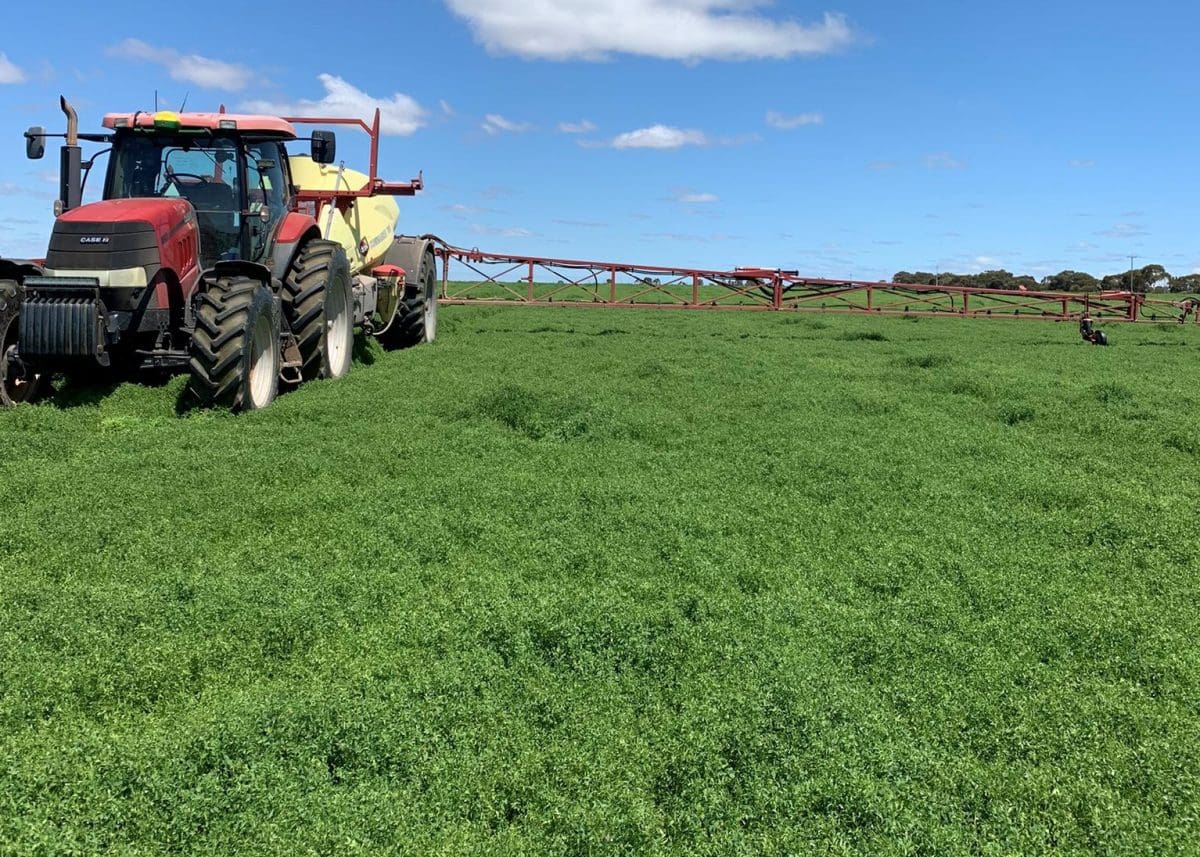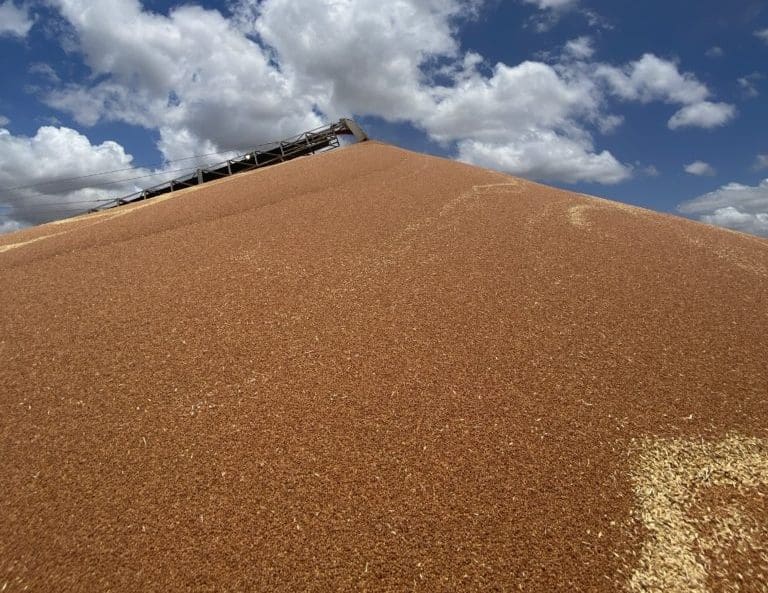
Spraying a flowering lentil crop late last month with fungicide at Snowtown in South Australia. Photo: Braydon Keech
UNCERTAINTY about the timing of southern Australia’s pulse harvest is keeping volume trade to a minimum, with growers wary about overcommitting on volume and quality, and traders following suit.
While Queensland’s chickpea harvest is well advanced, harvest of pulses in all states is running at least two weeks late due to unusually mild weather and successive rain events.
In later crops, rain is still building yield, as well as creating some management challenges for growers needing to continue fungicide applications to keep disease at bay in universally damp conditions.
Australia is one of the world’s biggest exporters of chickpeas, faba beans, lentils and lupins, and markets are waiting for a clearer picture on what volume and quality will be exported, and when.
AGT Foods Australia senior trader Mitchell Elks said importer interest was abnormally subdued for this time of year.
“It’s pretty quiet; Australia’s is the crop that should be coming off now, and pretty much the world is watching to see what happens.”
A record planting of mungbeans over summer is possible, but ideas are mixed about whether it will eventuate, given prolonged and widespread flooding in New South Wales.
Chickpeas
Container packers on the Darling Downs of southern Queensland are paying around $450-$500 per tonne for CHKPM-grade chickpeas with minor downgrading.
The market is little changed from last month, with the limited new-crop supply matching limited demand.
This reflects economic insecurity in some South Asian markets, and has offset the improved picture for container rates, reliability and availability.
Australian Choice Exports director James Hunt said container business has become easier to do in the past month or two.
“Rates have come down maybe 30 per cent on where they were a couple of months ago, the shipping is more reliable, and there’s more space on vessels,” Mr Hunt said.
“It’s almost turned on a dime.”
Global inflationary pressure is believed to be behind the container turnaround, as it has reduced the amount of consumer goods being shipped from China to Europe and the United States, and allowed some vessels to return to secondary routes which service South Asia and the Middle East.

A chickpea bunker at GrainCorp’s Mt McLaren site in CQ fills with chickpeas from the current harvest. Photo: GrainCorp
Pulse Australia northern regional agronomist Paul McIntosh estimates the Central Queensland (CQ) chickpea harvest is around halfway through, with quality mixed due to rain falling on ripe pods in most districts.
The upside has been yield, which has consolidated at 3.5-4 tonnes per hectare, up from 2.5-4t/ha seen in earlier crops.
“Yields have been outstanding in CQ, but field mould is an issue,” Mr McIntosh said.
The condition covers a number of fungal diseases, including botrytis grey mould.
It has caused widespread downgrading for many growers, who are delivering loads into CHKPM instead of the premium CHKP1 grade.
Crops on the Western Downs, and in the NSW-Queensland border region are a little later, and better quality is expected, provided conditions stay dry.
“It’s been such a cool winter, and those crops have a big biomass too; we won’t know how they’ll go until the header gets into them.”
Mr McIntosh describes NSW’s major chickpea-growing districts, including Moree, Narrabri and Walgett, as “a mess” after prolonged flooding and successive rains.
“NSW is bad to bad to bad. Yields down there? I’m not sure they’ll be harvesting those crops to find out.”
“There are not too many chickpeas still alive down there.”
However, isolated crops on sloping country have reasonable yield prospects, and some crops on flatter country may surprise once conditions dry out enough for growers to inspect and then harvest them.
ABARES September 2022 estimate for Queensland’s chickpea production of 320,000t from 205,000ha could have some upside.
However, the NSW estimate of 252,000t from 180,000ha may plummet to less than 100,000t due to flooding in the Namoi and Gwydir valleys, the state’s two biggest chickpea-growing regions.
Faba beans
Prices for faba beans have firmed in the past month in the southern market in response to the mixed outlook for new crop.
The fungal disease chocolate spot has cruelled production prospects from Bendoc, thought to be the biggest variety by area in Victoria.
Given the lateness of the crop already, and the downside now seen to Victoria’s production, fabas delivered to Victorian and South Australian packers are trading at $350-$450/t this week, up from a flat $350/t last month.
Prices for faba beans in NSW are softer, more like $250/t-$300/t delivered packer, largely reflecting the cost in freighting them to port.
In Queensland and in drier pockets of the NSW northern slopes, faba beans yielding 2.5-3t/ha are below average due to the unusually cool and wet growing conditions.
Despite widespread waterlogging in NSW and Victoria, Pulse Australia southern agronomist Phil Bowden said some crops have solid yield potential.
“There are some pretty good crops around that haven’t suffered with the wet,” Mr Bowden said.
The last time disease pressure was huge was in 2016, when preferred fungicides were in short supply.
Mr Bowden said chemical companies and resellers have done a good job of getting ahead of the problem this year as growers continue to apply fungicides to preserve their crops’ yield and quality potential.
“Prices are reasonable for a lot of crops, and it’ll mean their gross margins aren’t too badly affected, even after several fungicide applications.”
The height and vertical habit of fabas means crops on undulating country have been able to dry out on the fine and breezy days between rain events, and better resist the degree of fungal pressure which has bitten into many chickpea and lentil crops.
Mr Elks said Bendoc faba beans in Victoria were the exception.
“Chocolate spot has absolutely decimated Bendoc in Victoria, but it hasn’t been a huge issue in NSW,” Mr Elks said.
Domestic stockfeed manufacturers are expected to continue volume buying of faba beans and also kaspa field peas to provide protein not available in new-crop wheat or hay due to the wet and flood-affected season.
“There’s certainly interest from them in faba beans; kaspa peas and beans are the ones they’ll target.”
Lentils
Prices for lentils have sunk to around $780/t delivered packer and port, down roughly $20/t from last month, due mainly to the firmer Australian dollar.
SA and Western Australia have brighter quality prospects than eastern states, and Mr Elks said SA growers have locked in some tonnage already, and some containerised new-crop lentils have already been shipped.
“Some growers in SA have done a decent chunk of forward selling.”
“Container availability has freed up, and now it’s the (importing) country’s ability to pay for product that is the concern.”
Trade sources report Bangladesh, Egypt, Pakistan and Sri Lanka are all bearing some increased counterparty risk.
South Australia is on track to produce its biggest ever lentil crop.
“It’s a once-in-a-lifetime crop for some people,” Pinion Advisory agribusiness consultant Rebekah Starick said.
“The disease pressure’s definitely on, and where growers haven’t spray topped or sprayed out and the crops are still green, rain shouldn’t be an issue.”
November is normally warm to hot and dry in SA, but it too has had a wet month to date, with 20-50 millimetres of rain falling in most growing regions in the past week alone.
Ms Starick said the impact of this latest rain, and accompanying winds, are not yet known.
“A lot of crops did get canopy closure, and that means the plants can support each other in windy conditions; if they didn’t get canopy closure, pods can knock together and you could lose some yield.
“If the yields, that people are expecting, come out of the paddock ,there’ll be a lot of lentils out of SA in particular.
“The question now is what the quality is going to be, and there’s no point panicking about that until we get a header into the paddock.”
Ms Starick said SA’s expanded cleaning and grading capacity meant that even if mixed quality was harvested, good quality can be exported.
“The question is: Can we store it?
“Last year, we had rain delays too, and that pushed us into a narrow window for harvest.
“We’re going to have a tight window again, but with more tonnage.”
“It will put a lot of pressure on supply chains.”
Mungbeans
Prices for old-crop mungbeans have eased by around $50/t in the past month as trade volumes dwindle to a trickle, and new-crop sales are limited ahead of the start of widespread planting.
Mr Hunt said mungbean volume on old-crop has dwindled to a trickle.
“Demand has been pretty soft on anything left on old-crop, which is very little and low quality at that.
“We were achieving some really good prices on what came out of the woodwork at $1350 DCT and the like, but the quality we’re seeing now is below manufacturing.
“You would achieve $1100/t DCT for something near a manufacturing grade.”
Mr Hunt said while interest in growing mungbeans in NSW is high, a big and muddy winter-crop harvest has to be dealt with first.
“The clock is ticking and the floods are still roaring; chances of a big crop in NSW are dwindling.”
The Australian Mungbean Association is hosting three mungbean agronomy courses, the first in Toowoomba on November 23-24, followed by Dubbo on December 13-14 and Narrabri on December 15-16.
Many NSW growers who were unable to plant their intended winter crop due to waterlogging are now looking to grow an opportunity crop of mungbeans over summer to generate some income.
“We expect mungbeans to be fairly large this year in NSW; you can grow a crop of mungbeans and still have enough moisture to grow wheat,” Mr McIntosh said.

Certainly we will have some storage issues in SA, if we see the lentil yields as expected at or above 3t/ha.